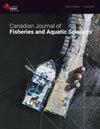Fishery Participation and Location Choice Model: The West Coast Salmon Troll Commercial Fishery
IF 2.2
2区 农林科学
Q2 FISHERIES
Canadian Journal of Fisheries and Aquatic Sciences
Pub Date : 2023-08-02
DOI:10.1139/cjfas-2023-0001
引用次数: 0
Abstract
Random utility models have been widely used to model spatial choice within fisheries, but less attention has been paid to modeling participation and movement between fisheries. Fishers may switch fisheries in response to time closures or changes in profitability potentially creating management implications for those fisheries as well as the fishery with the closure. We used a random utility maximization framework to model participation, fishery choice, and location choice for a large fleet of West Coast salmon trollers, many of which also participate in other fisheries. We used the model to demonstrate substitution effects across fisheries due to spatial policies implemented in the salmon fishery. Our work suggests spatial management of a single fishery needs to take into consideration fishers’ full choice set to predict behavioral responses to spatial policies. Our analysis also provides insights into how fishers construct multifishery harvest strategies that enable them to more fully use capital or adjust to closures or changes in relative profitability.渔业参与与区位选择模式——西海岸三文鱼养殖场
随机效用模型已被广泛用于对渔业中的空间选择进行建模,但对渔业之间的参与和运动建模的关注较少。渔民可能会根据时间关闭或盈利能力的变化而改变渔业,这可能会对这些渔业以及关闭后的渔业产生管理影响。我们使用随机效用最大化框架对西海岸大型鲑鱼控制船队的参与、渔业选择和位置选择进行了建模,其中许多还参与了其他渔业。我们使用该模型来证明由于鲑鱼渔业中实施的空间政策,整个渔业的替代效应。我们的工作表明,单一渔业的空间管理需要考虑渔民的完整选择集,以预测对空间政策的行为反应。我们的分析还深入了解了渔民如何构建多种捕鱼策略,使他们能够更充分地利用资本或适应关闭或相对盈利能力的变化。
本文章由计算机程序翻译,如有差异,请以英文原文为准。
求助全文
约1分钟内获得全文
求助全文
来源期刊

Canadian Journal of Fisheries and Aquatic Sciences
农林科学-海洋与淡水生物学
CiteScore
4.60
自引率
12.50%
发文量
148
审稿时长
6-16 weeks
期刊介绍:
The Canadian Journal of Fisheries and Aquatic Sciences is the primary publishing vehicle for the multidisciplinary field of aquatic sciences. It publishes perspectives (syntheses, critiques, and re-evaluations), discussions (comments and replies), articles, and rapid communications, relating to current research on -omics, cells, organisms, populations, ecosystems, or processes that affect aquatic systems. The journal seeks to amplify, modify, question, or redirect accumulated knowledge in the field of fisheries and aquatic science.
 求助内容:
求助内容: 应助结果提醒方式:
应助结果提醒方式:


